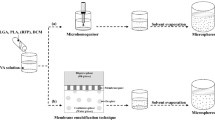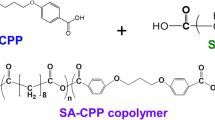Abstract
Microspheres are a potential delivery system for controlled and sustained drug release. Polymeric microspheres are commonly prepared by the solvent evaporation technique whereas waxy microspheres by the melt dispersion technique. The goal of this study was to prepare a surfactant (Span 60)—Ibuprofen microspheres using both techniques. Ibuprofen-Span 60 microspheres were fabricated with different drug to polymer weight ratios of 3:1, 1:1 and 1:3 and characterized by particle size, in vitro dissolution, infrared spectroscopy, x-ray diffraction and scanning electron microscopy. The actual drug content increased with increasing the concentration of anti-aggregating agent (polyvinylpyrolidone). The actual drug content and drug encapsulation efficiency was markedly higher in case of microspheres prepared by a solvent evaporation technique compared to that prepared by a melt dispersion one using the same theoretical drug content. The microspheres were spherical with irregular surfaces. The in vitro release showed no burst effect and incomplete drug release. The rate and total drug released from the microspheres prepared by a solvent evaporation technique are higher than those prepared by using the melt dispersion technique. FTIR rolled out the chemical changes of the drug in Span 60 microspheres. The X-ray diffraction pattern of the microspheres prepared by using a solvent evaporation technique showed a decrease in the drug crystallinity. The drug crystallinity in microspheres prepared by the melt dispersion technique decreased with increasing the theoretical drug content. The drug entrapment mechanism is responsible for the changes in drug physicochemical properties and in vitro release.







Similar content being viewed by others

References
Yüksel N, Aydmli A, Ozalp Y, Ozdemir N. Evaluation and preparation of controlled release lipid microspheres of sulphamethizole by a congealable disperse phase encapsulation method. Acta Poloniac Pharm Drug Res. 2000;57(3):187–92.
Bodmeier R, Chen H. Preparation and characterization of microspheres containing the anti-inflammatory agents, indomethacin, ibuprofen, and ketoprofen. J Controll Rel. 1989;10:167.
Follonier N, Doelker E. S.T.P. Biopharmaceutical comparison of oral multiple-unit and single-unit sustained-release dosage forms. STP Pharm Sci. 1992;2:141–58.
Akiyama Y, Yoshioka M, Horibe H, Hirai S, Kitamori N, Toguchi H. Novel oral controlled release microspheres using polyglycerol esters of fatty acid. J Control Rel. 1993;26:1–10.
Hassan EE, Eshra AG, Nada AH. Formulation of prolonged release lipid micropellets by emulsion congealing: optimization of ketoprofen entrapment and release Int. J Pharm. 1995;121:149.
Gowda DV, Srivastava A, Aravind Ram AS, Datta V, Hatna S. Encapsulation of Lornoxicam into spermaceti microspheres and comparative bioavailability study. Int J Drug Deliv. 2014;6:07–13.
Giannola LI, de Caro V, Severoino A. Carnauba wax microspheres loaded with valproic acid: preparation and evaluation of drug release. Drug Dev Ind Pharm. 1995;21:1563–72.
Edward JP, Terrence LB, Li S. The chemistry of waxes and sterols. In: Casimir CA, David BM, editors. Food lipids: chemistry, nutrition, and biochemistry. 2nd ed. New York: Marcell Dekker; 2002.
Adeyeye CM, Price JC. Development and evaluation of sustained release ibuprofen-wax microspheres. I. Effect of formulation variables on physical characteristics. Pharm Res. 1991;8:1377–83.
Adeyeye CM, Price JC. Development and evaluation of sustained release ibuprofen-wax microspheres. II. In vitro dissolution studies. Pharm Res. 1994;11:575–9.
Brannon-Peppas L. Recent advances on the use of biodegradable microparticles and nanoparticles in controlled drug delivery. Int J Pharm. 1995;116(1):1–9.
Karasulu E, Yesim Karasulu H, Ertan G, Kirilmaz L, Güneri T. Extended release lipophilic indomethacin microspheres: formulation factors and mathematical equations fitted drug release rates. Eur J Pharm Sci. 2003;19(2–3):99–104.
Vishal Gupta N, Gowda DV, Balamuralidhara V, Khan MS. Preparation and Comparative Bioavailability Studies of Indomethacin-Loaded Cetyl Alcohol Microspheres, Journal of Pharmaceutics, ID 109837, 9 pages, 2013. http://dx.doi.org/10.1155/2013/109837.
Paradkar AR, Ambike AA, Jadhav BK, Mahadik KR. Characterization of curcumin-PVP solid dispersion obtained by spray drying. Int J Pharm. 2004;271:281–6.
Obaidet AA, Obaidet RM. Controlled release of tramadol hydrochlo-ride from matrices prepared using glyceryl behenate. Eur J Pharm Biopharm. 2001;52:231–5.
Nikam VK, Gudsoorkar VR, Derle DV. Development and Evaluation of Ketoprofen Loaded lipid Microspheres for controlled release Drug Delivery. IJAPBC Int J Adv Pharm Biol Chemistry. 2015;4(2):287–93.
Bodmeier R, Wang J, Bhagwatwar H. Process and formulation variables in the preparation of wax microparticles by melt dispersion technique for water insoluble drugs. J Microcapsul. 1992;9:89–98.
Obaidet AA, Obaidet RM. Controlled release of tramadol hydrochloride from matrices prepared using glyceryl behenate. Eur J Pharm Biopharm. 2001;52:231–5.
Current EU approved additives and their E Numbers, Food Standards Agency, https://en.wikipedia.org/wiki/Sorbitan_monostearate Accessed 26 November 2010.
Hendy RJ, Butterworth KR, Gaunt IF, Kiss IS, Grasso P. Long-term toxicity study of sorbitan monostearate (Span 60) in mice. Food Cosmet Toxicol. 1978;16(6):527–34. doi:10.1016/S0015-6264(78)80219-3.
Akhilesh D, Bini KB, Kamath JV. Review on span-60 based non-ionic surfactant vesicles. Int J Res Pharm Biomed Sci. 2012;3:6–12.
Paradkar AR, Maheshwari M, Ketkar AR, Chauhan B. Preparation and evaluation of ibuprofen beads by melt solidification technique. Int J Pharm. 2003;255:33–42.
Gupta K, Pal R, Chakraborty M, Debnath R. Design, evaluation and optimization of microcapsules of leflunomide with Eudragit RL100 and Eudragit RS100 by solvent evaporation technique. Asian J Pharm. 2009;3(4):309–13.
El-Helw M, Al-Hazimi M, Youssef M. Preparation of sustained release phenobarbitone microspheres using natural and synthetic polymers. JKAU Med Sci. 2008;15(2):39–53.
Behera BC, Sao SK, Dhal S, Baric BB, Gupta BK. Characterization of glipizide-loaded polymethacrylate microspheres prepared by an emulsion solvent evaporation method. Trop J Pharm Res. 2008;7(1):879–85.
Mao S, Shi Y, Li L, Xu J, Schaper A, Kissel T. Effect of process and formulation parameters on characteristics and internal morphology of poly (D, L-lactide-co-glycolide) microspheres formed by the solvent evaporation method. Eur J Pharm Biopharm. 2008;68:214–23.
Yerriswamy B, Reddy CLN, Prasad CV, Subha MCS, Rao KC, Venkatareddy G. Controlled release studies of 5- fluorouracil through poly (vinyl caprolactum-co- vinyl acetate) microspheres. Asian J Pharm. 2010;4(3):200–4.
Costa P, Lobo J. Modelling and comparison of dissolution profiles. Eur J Pharm Sci. 2006;13:123–33.
Kroschwitz J. Encyclopedia of Polymer Science and Engineering, Microencapsulation, 2nd ed, 1987 Volume 9, 724.
Celle M, Menei PH, Benoit J. Preparation and characterization of 5 flurouracil-loaded microparticles as biodegradable anticancer drug carriers. J Phann Pharmacol. 1995;47(108):4.
Avu-izza K, Garcia-contreras L, Lu R. Preparation and evaluation of sustained release AZT-loaded microspheres. J Pharm Sci. 1996;85:2–8.
Korsatko B, Korsatko W, lafferty R. Third European Congress of Biopharmaceutics and Pharmacokinetics, proceeding-Volume 1, Biopharmaceutics, 1987:243–251.
Aravind Ram ASM, Vijay K, Afrasin M, Gowda DV, Mohammed SK. Encapsulation of olanzapine into Waxes/fat microspheres: preparation, Characterization and Release kinetics. Elixir Pharm. 2012;48:9329–35.
Basarkar GD, Shirsath GN, Patil SB. Development of microspheres containing diclophenac diethylamine as sustained release topical formulation. Bull Pharm Res. 2013;3(1):14–22.
Fetih GN. Formulation and characterization of gelucire pellets for sustained release of ibuprofen. Bull Pharm Sci Assiut Univ. 2010;33(2):217–24.
Nakanishi K. Infrared absorption spectroscopy. San Francisco: Holden-day Inc; 1974.
Adibkia K, Siahi MR, Nokhodchi A, Javadzedeh A, Barzegar M, Barar J, Mohammadi G, Omidi Y. Piroxicam nanoparticles for ocular delivery: physicochemical characterization and implementation in endotoxin-induced uveitis. J Drug Target. 2007;15:407–16.
Pignatello R, Bucolo C, Spedalieri G, Maltese A, Puglisi G. Flurbiprofen-loaded acrylate polymer nanosuspensions for ophthalmic application. Biomaterials. 2002;23:3247–55.
Mudgil M, Pawar P. Preparation and in vitro/ex vivo evaluation of moxifloxacin-loaded LGA nanosuspensions for ophthalmic application. Sci Pharm. 2013;81:591–606.
Jayer S, Durance T, Wang R. Physical characterization of drug loaded microcapsules and controlled in vitro release study. Open Biomater J. 2010;2:9–17.
Anwer M, Ahmed M, Ansari M, Khan T. Inclusion complex of solid state aspirin with fulvic acid: dissolution, permeability, stability and preliminary pharmacological studies. J Biol Sci. 2013;13(5):203–312.
Semalty A, Semalty M, Singh D, Rawat M. Development and characterization of aspirin-phospholipid complex for improved drug delivery, int. J Pharm Sci Nanotechnol. 2010;3(2):940–7.
Rogers MA. Novel structuring strategies for unsaturated fats meeting the zero-trans, zero-saturated fat challenge: a review. Food Res Intl. 2009;42(7):747–53.
Solís-Fuentes J, Dur´an-de-Baz´ua M. Mango seed uses: thermal behaviour of mango seed almond fat and its mixtures with cocoa butter. Bioresour Technol. 2004;92(1):71–8.
Kerr RM, Tombokan X, Ghosh S, Martini S. Crystallization behaviour of anhydrous milk fat—sunflower oil wax blends. J Agric Food Chem. 2011;59(6):2689–95.
Sagiri SS, Singh VK, Pal K, Banerjee I, Basak P. Stearic acid based oleogels, a study on the molecular, thermal and mechanical properties. Mater Sci Eng C. 2015;48(0):688–99.
Uvanesh K, Sagiri SS, Senthilguru K, Pramanik K, Banerjee I, Anis A, Al-Zahrani SM, Pal K. Effect of Span 60 on the microstructure, crystallization kinetics, and mechanical properties of stearic acid oleogels: an in-depth analysis. J Food Sci. 2016;81(2):380–7.
Garti N, Wellner E, Sarig S. Effect of food emulsifiers on crystal structure and habit of stearic acid. J Am Oil Chem Soc. 1981;58(12):1058–60.
Johansson D, Bergenstahl B. The influence of food emulsifiers on fat and sugar dispersions in oils. I. Adsorption, sedimentation. J Am Oil Chem Soc. 1992;69(8):705–17.
Paradkar AR, Maheshwari M, Ketkar AR, Chauhan B. Preparation and evaluation of ibuprofen beads by melt solidification technique. Int J Pharm. 2003;255:33–42.
Zhang Y, et al. DDSolver: an add-in program for modeling and comparison of drug dissolution profiles. AAPS J. 2010;12(3):263–71.
Syed A. Modulating the release behavior and kinetic evaluation of diclofenac sodium from natural polymers. Int J ChemTech Res. 2010;2(2):834–41.
Jovita K. Optimaization of methods for the preparation of famotidine floating microspheres. Der Pharmazie letter. 2011;3(6):68–76.
Author information
Authors and Affiliations
Corresponding author
About this article
Cite this article
Mady, O. Span 60 as a Microsphere Matrix: Preparation and in Vitro Characterization of Novel Ibuprofen-Span 60 Microspheres. J Surfact Deterg 20, 219–232 (2017). https://doi.org/10.1007/s11743-016-1907-7
Received:
Accepted:
Published:
Issue Date:
DOI: https://doi.org/10.1007/s11743-016-1907-7



